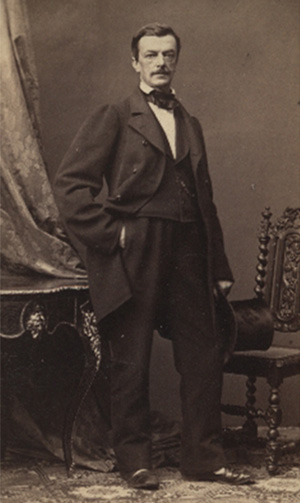
The Austrian coleopterist Ludwig Redtenbacher (1814–1876) in 1862. Image courtesy of Editha Schubert and the Senckenberg Deutsches Entomologisches
Institut Portrait collection, Müncheberg, Germany.
.
<
<
|
|
Born on 10 June 1814 in the small town of Kirchdorf an der Krems in Upper
Austria, Ludwig Redtenbacher was one of the main nineteenth-century coleopterists of
his country. Having studied medicine at the University of Vienna between 1833 and 1838, he took his doctorate at the same university in 1843 with a thesis titled “Tentamen
dispositionis generum et specierum coleopterorum pseudotrimerorum Archiducatus Austriae”, in which he addressed the taxonomy of the Endomychidae and Coccinellidae
from the Archduchy of Austria. In 1847, Redtenbacher became an assistant at the insect collection of the Court Cabinet of Natural Objects (from the German “Hof-
Naturalienkabinett”, predecessor of the present Naturhistorisches Museum Wien), in the Austrian capital, where he had worked earlier as a volunteer assistant between 1834 and 1840. In 1851, he moved to Prague as a professor of zoology at Prague University, but the following year went back to Vienna to hold the position of first adjunct curator at the Hof-Naturalienkabinett under request of the Austrian Emperor Franz Joseph I. After the death of the entomologist Vincenz Kollar (1797–1860), Redtenbacher replaced him as the main curator at the Hof-Naturalienkabinett and, in 1867, he was appointed its
director. In 1870, he was awarded the title of Regierungsrat of the institution. After suffering from deafness in his final years, Redtenbacher died at the age of 61 in Vienna on the 8 February 1876.
Although not a prolific author, Redtenbacher published some significant works dealing especially with the beetle fauna of the German-speaking countries of central Europe: besides his above cited doctoral thesis, he presented an influential three-edition treatise on the Coleoptera of Austria, and introduced a study of the “German beetles” using what he called a new “analytical method” (“analytische Methode”) in entomology. Redtenbacher was also responsible for studying the insects collected by a number of Austrian world exploratory expeditions: In 1843, he published the Coleoptera portion of the geologist Joseph Russeger’s (1802–1863) report of his expedition through Greece, Anatolia, Egypt, and Syria. In collaboration with Vincenz Kollar, he also studied the insects collected by the botanists and explorers Carl von Hügel (1796–1870) in Kashmir and the Himalayas, and Theodor Kotschy (1813–1866) in Syria. His only contribution to New World scarab beetles, nonetheless, was his study of the Coleoptera material gathered during the circumnavigation of the globe by the
Austrian frigate SMS Novara.
Reference
VAZ-DE-MELLO F.Z. and M. CUPELLO M. 2018. The type specimens of South American dung
beetles, Part II: The species described by the Austrian coleopterist Ludwig Redtenbacher (1814–1876) in the 1868 part of the “Reise der österreichischen Fregatte Novara um die Erde” (Insecta: Coleoptera, Scarabaeidae, Scarabaeinae). Annalen des Naturhistorischen Museums in Wien, B 120: 41–58. |